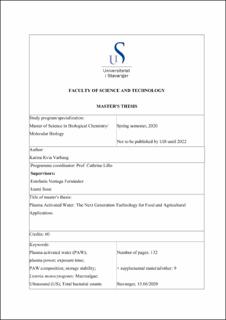| dc.description.abstract | Plasma activated water (PAW) has recently gained increased attention as a next generation non-thermal food processing technology. It has promising potential as a eco-friendly alternative to traditional decontamination methods in the food industry, as well as promising applications in agriculture, such as plant growth enhancement.
In this MSc thesis, PAW composition and stability during four-week storage at different temperatures, relevant for industry settings, (10, 4 and -20 °C) were assessed as a function of PAW operating conditions (i.e. plasma power and activation time). Increasing plasma power (25 and 35 W) and activation time (10 and 30 min) resulted in a significant drop in pH (up to 2.5 ± 0.1) and significantly higher oxidation reduction potential (ORP) level (up to 284.1 ± 11.5 mV) and concentration of the monitored reactive oxygen and nitrogen species (RONS), i.e. nitrates, nitrites and hydrogen peroxide (up to 342.5 ± 13.6, 1.6 ± 0.1 and 1.1 ± 0.2 mg/L, respectively). Furthermore, the presence of carbonic compounds (carbonic acid, bicarbonate and carbonate ion) in PAW significantly increased with activation time, where the main specie was carbonic acid (maximum of 693.3 ± 131.9 μM), and estimation of the hydronium ion and hydroxide levels increased and decreased, respectively. The nitrous and nitric acid in PAW both increased with increasing plasma power and activation time. Regarding PAW storability, the pH, ORP and nitrates level remained stable during the four-week storage, independently of the temperature. However, nitrites levels were not detectable after 24 h for all operating conditions and storage temperatures, except for the most severe activation settings (36 W for 30 min), where a significant decrease was still detected only at 10 and 4 °C. Hydrogen peroxide levels were also non-detectable after 24 h for all operating conditions and storage temperatures, which was attributed to its instability in acidic environments.
The potential of PAW for microbial inactivation, alone or combined with ultrasonication (US), was assessed on planktonic cells of Listeria monocytogenes, with high prevalence in fresh produce, and also on wild harvested macroalgal biomass (Laminaria hyperborea), as a sustainable alternative to current preservation strategies. About 5 log reductions on L. monocytogenes suspensions were achieved after 5 min treatment with PAW, whilst there was no significant difference for the synergistic effect was observed when combined with US. For macroalgae decontamination, the combined effect of PAW and US resulted in about ≈ 2 log reductions of the total viable counts. Thus, the potential of PAW to extended product shelf-life and reduce food waste generation was demonstrated. Assessment of PAW as a nitrogen rich fertilizer and growth enhancement was conducted on Solanum lycopersicum (tomato) cultivar Heinz plants, resulting in significantly longer and heavier plants irrigated with PAW, alone and with the synergistic effect with a nutritional solution. In conclusion, this MSc thesis has demonstrated the potential of PAW as a promising alternative to traditional sanitizers applied in the food industry, as well as to mineral fertilizers in agriculture applications. | en_US |

